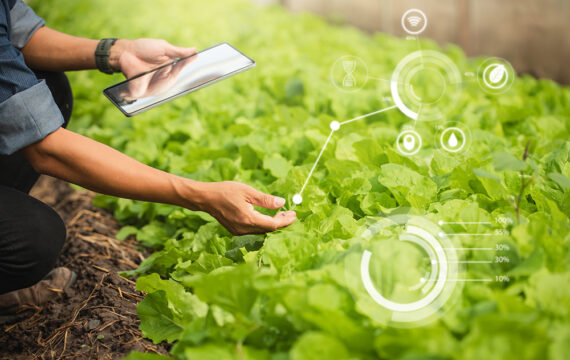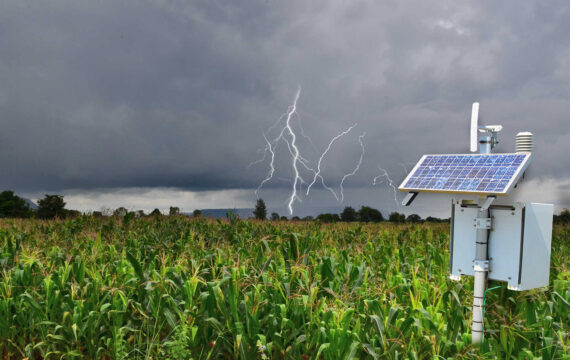Today, people want to know exactly where their food comes from. A desire to eat healthy combined with the widespread adoption of technology across all domains has resulted in agribusinesses searching for supply chain management software to improve food safety, food quality, and the traceability of the entire farming supply chain.
Demand for information about food

Source: Consumer Preferences for Traceable Food
The human population continues growing, as does consumers’ demand for digital services targeted at their needs. Farmers and agribusinesses should consider introducing blockchain technology in agriculture and farm management software to improve the financial performance of farmland and meet the demand for food of a growing population.
The agricultural sector needs to undergo technological transformation to:
- satisfy the demands of a growing population for more high-quality food
- advance technological solutions to meet changing consumer needs
- encourage sustainable agricultural practices and lower environmental footprints
- decrease agricultural supply chain costs
- establish and follow firm sanitary and phytosanitary (SPS) standards
- sustain profitable operations of farmlands and agribusinesses
- increase the incomes of small farms, private farmers, and food producers
Agricultural technologies like precision farming, mapping of farmlands, IoT sensors, vertical farming systems, location intelligence, and crop management software — in addition to transportation technologies — are empowering agricultural businesses to achieve better outcomes in terms of food production and the entire supply chain management in agriculture. An increased demand for food brings new issues with it, such as counterfeit products that threaten food supply chains at different stages. Lack of transparency and low efficiency put farmers and consumers at a disadvantage.
Ultimately, blockchain farming and distributed ledger technology (DLT) have the potential to increase efficiency, transparency, and trust throughout agricultural supply chains. Blockchain for agriculture supply chain can empower all market players by building relationships of trust.
The blockchain for supply chain can transform the agricultural industry by:
- simplifying all stages of the agricultural supply chain
- tracking a product along its entire path from farmland to store shelf
- improving food safety and eliminating counterfeit items
- reducing financial risks and promoting inclusive trade
- providing farmers and businesses with access to agricultural financial services
- generating smarter market data for better decision-making with data science in agriculture
- legally proving certifications to relevant authorities
What are the benefits of blockchain in agriculture supply chain?

Challenges of implementing blockchain technology in agriculture and steps to overcome them
Supply chain management in agriculture is more complex than other supply chains, as agricultural production depends on factors like weather, pests, and diseases that are hard to predict and control. The lack of traceability in the agricultural supply chain leads to slower financial transactions and often intensive manual work. In addition, counterfeits may appear at each stage of the supply chain and bring dangerous consequences to all business stakeholders, governments, and consumers.
Negative impact of counterfeits in agriculture

Source: Counterfeiting in African Agriculture Inputs – Challenges & Solutions
Supply chain blockchain services and initiatives can mitigate the risk of counterfeits and increase the efficiency of blockchain-based agriculture by providing transparency and eliminating intermediate links in the agricultural value chain. In addition, by reducing uncertainty and enabling trust among market players, distributed ledgers and smart contracts provide a real opportunity for more inclusive market participation among smallholders and micro, small, and medium enterprises (MSMEs).
The basic challenge of agricultural supply chains lies in the transportation of products. While transaction data can be traced by the cryptographic fingerprint attached to each transaction, the movement of a physical product along a supply chain from farm to consumer requires a much more immutable product–process link. Several well-known technologies exist to establish this link.
Technologies to trace physical products along the agricultural supply chain:
- QR codes on the product’s packaging (QR codes in agriculture are already used but still require regulators to monitor authenticity from a seed to a ready product.)
- Advanced radio frequency identification (RFID) chips, RFID supply chains, and RFID applications in agriculture
- NFC agriculture technology for contactless reading of product data
- Crypto-anchor technology for agriculture (IBM recently developed cryptographic anchors to ensure product authenticity for DLT. This technology is promising but still at the early stages of development.)
The biggest potential for blockchain technology in agriculture market
Let’s take a typical supply chain of crops and elaborate on the potential of agriculture supply chain management software at each stage. The growing demand for traceability of food origins is bringing high potential for QR codes on consumer products. Consumers can scan codes on packaging to know the exact location where a product was grown or raised and see other information about the product’s life cycle up to the store shelf.
The supply chain starts with a supplier of seeds, eggs, or any other agri-food input who registers their products in a digital ledger by filling out information on product quality, pesticides used, sanitation, and transportation. After this initial data has been submitted, the DLT network will trace, verify, and record this data throughout the supply chain. The DLT will also update product data with information on the time of expiration, transit conditions, and relevant export/import certifications. The chart below shows the use of blockchain for agriculture supply chain.
Supply chain management in agriculture with distributed ledger technology

Use cases of the blockchain in agriculture supply chain
According to the United Nations, counterfeit food costs the global economy nearly $40 billion per year. Research by MarketsandMarkets reveals that with implemented blockchain, agriculture supply chain generated $60.8 million in market value in 2018 and is predicted to generate $429.7 million in value by 2023, growing at a CAGR of 47.8% during the projected period. Blockchain technology in agriculture market like distributed ledgers and smart contracts have the ability to weed out counterfeits in agri-food production and supply chains, handing healthier products to consumers, generating trust between business players, and enabling a better life at a global scale.
Through deep research and real-life testing of ways to apply the blockchain to the agri-food industry, businesses can start recognizing the most beneficial blockchain use cases to improve the agricultural supply chain. So, how can blockchain help farmers?
Food safety
The use of blockchain has the same chances to become as beneficial as the use of the IoT in agriculture. The blockchain can provide an efficient and reliable solution to the urgent need for product traceability and controlling supply chain. By recording information about products at every stage of the agricultural supply chain, a blockchain helps to remove redundant processes, ensure quality control, and monitor storage conditions. Agricultural companies already monitor crops with smart IoT devices, and the application of distributed ledger technology will reinforce sensing technology by recording and verifying all data.
Agricultural insurance
Self-executing smart insurance contracts built on distributed ledger technology will provide better insurance programs for private farmers, agricultural holdings, and all actors in the supply chain. Smart contracts will eliminate the human factor from assessing insurance claims, making the claim process simpler, faster, and more transparent. Smart contracts will also minimize the risks of false claims and corruption among insurance providers, as no actor will be able to alter insurance policies once they’re agreed upon.
The blockchain can bring transparency to agricultural financial transactions, credit history, and financial agreements for smallholders who want to invest in farming. Shared access and irreversible agreements will allow smaller farmers to pay for raw materials and machinery partially or after delivery and guarantee fair market pricing.
Environmental sustainability
Climate change and unpredictable weather influence agriculture more than other industries. In addition to taking responsibility for our planet’s future, agribusinesses have to follow requirements of various environmental initiatives like climate or green bonds. Companies are facing more and more obligations for monitoring, verifying, and reporting according to sustainability requirements to prove their climate friendly farming practices to investors to keep their businesses running.
More ways of how can blockchain help farmers:
- Improved quality of products and fewer diseases originated from food
- Fair pricing through the whole value chain for all actors
- Sustainable business and reduction of waste
- Financing and insurance for small farmers
- Facilitation of financial transactions in emerging economies
- Traceability throughout the value chain
- Emissions reductions and support for environmentally friendly initiatives
- Consumer awareness and increased consumer satisfaction
- More informed consumer purchasing decisions
- Decreased transaction fees and less dependence on intermediate services
- Transparent transactions and elimination of fraud
- Data accessibility while maintaining privacy according to regulations
Agriculture supply chain management software based on blockchain and related technologies like IoT, RFID, NFC, and QR codes can bring benefits related to automation, productivity, and transparency depending on the type of goods produced by agribusinesses.
Goals that can be achieved by applying the blockchain to different agricultural products

Lessons learned from other industries and blockchain mistakes to avoid
The blockchain continues to draw attention across industries. This technology promises to change the way we conduct our daily routines and run our businesses.
Feasibility of blockchain by industry

Source: McKinsey Digital
One may argue that the blockchain is all hype and still hasn’t proven its reliability across industries; people have simply raised a lot of buzz about this technology to attract investors’ money. However, most failures at implementing blockchain technology originate from a faulty understanding of the technology’s readiness. Blockchain adopters often step on the same rake, repeating the mistakes of their predecessors.
Gartner Says 80% of Supply Chain Blockchain Initiatives Will Remain at a Pilot Stage Through 2022.
Misunderstandings and misuse of the blockchain
Companies often start blockchain projects without assessing the entire business and technology ecosystem they’re already running. To implement a blockchain successfully, companies should find untrusted links and apply digital ledger technology exactly at these stages of the value creation chain.
Assuming the blockchain is a ready solution
Companies often expect to get positive results right after introducing a blockchain into their business operations. However, the blockchain is just a set of tools that must be applied in the right place. While there are around 100 blockchain decentralized platforms on the market, most appear and disappear within 24 months.
Viewing the blockchain as a database or storage system
A distributed ledger is not a database in the common sense of the term. Data stored in a distributed ledger cannot be altered by any parties. Actually, a blockchain offers very limited data management capabilities, and sometimes companies are better off developing a comprehensive database than using a distributed ledger.
Assuming that blockchain standards exist
Most blockchain-based solutions are still in the development phase. When developing an exclusively blockchain product, companies can run into poor integration with other services that don’t support their solution. Another issue arises when scaling a blockchain product or transferring it to another software development vendor.
Want to improve the traceability of products and the transparency of the supply chain for your agribusiness? Contact Intellias experts. As a trusted custom software development company, we’ll help you come up with the best tech solution for your specific needs.




